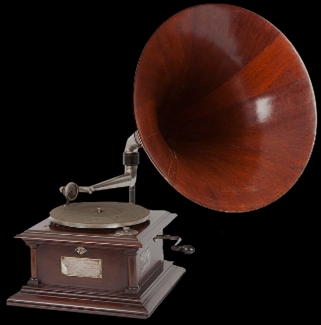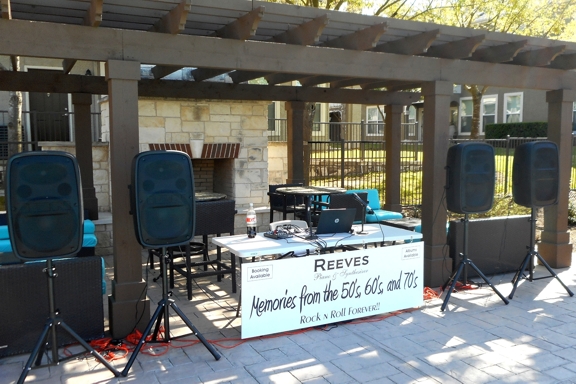Sound Fidelity
When I was an obnoxious little pre-schooler, (as opposed to an obnoxious rest of my life person,) our house was on an odd shaped wedge of land mostly bordered on three sides by streets. Hence we had only one real "next door neighbor."
She was a extremely spry lady in her nineties whose passions were her garden and her daily baking. I wasn't all that enamored with the garden, but was willing to help as much as a little brat could because she always had fresh home made cookies, candies, cakes, pies, and kolaches in abundance.
She also had something that fascinated my budding engineer mind. In her parlor was a wind up Victrola that mesmerized me.

I was familiar with my parent's record player, but there was something about the all mechanical nature of it that I couldn't resist. It played records at 78 RPM's and even to my young ears, the sound quality left a lot to be desired. It wasn't that it worked pretty well, but that the thing worked at all. Amazing.
The folks' record player also played the 78's but because of the electronics, played them with much more fidelity. I've still got a number of old 78's from that era. As it was a fairly new machine, it also had provisions for the new "long playing 33 1/3 rpm" (debuting about 1948) and slightly newer "45 rpm" (debuting about 1949) records starting to hit the market.
It wasn't long until High Fidelity recording were beginning to be produced. The difference was immediately noticeable - the music was starting to sound almost "real."
In the mid 50's Stereophonic records were starting to be produced. I've got a couple of twin sets where one record was monaural and the other was stereo. Played one after the other, the difference was incredible.
Progress was extremely rapid after that - better turntables, better amplifiers, better speakers. Compact cassette tapes appeared that were a step back in fidelity initially until Ray Dolby introduced Dolby Noise Reduction, at which point tape mostly caught up with the vinyl LP's.
By high school, my "personal stereo" had a Dual turntable, a 100 watt RMS Heathkit stereo amplifier I'd built, and speakers with 12 inch woofers, compatible mid range drivers, and high frequency tweeters.
1982 was a banner year because Compact Discs were introduced. A CD recording is a digital representation of sound. That provides it an effective frequency response from almost 0 Hz (direct current) to 22,000 Hz - beyond human hearing. It's about as a close to perfect sound recording as you'll find.
My current "personal stereo" consist of either a CD player or more commonly one of my computers delivering music to 1600 watts RMS of Class D amplifiers which power eight high frequency horns, four 9 inch midrange speakers, four 15 inch woofers, and a pair of 24 inch subwoofers (when I pull the 24 inch "big boys" out of storage.) Some of the system is what I take with me to play at events. Here's my typical DJ setup with four portable speaker towers.

All of my CD's are recorded to the same audio response standard.
So, with all these advances in audio quality that have been made over the long history of recorded music - - -
WHY THE HELL is most music today played on cell phones (and other ilk) with speakers the size of the paper from a hole punch (if they are even that big) and with an amplifier that's got about as much power as a lame cockroach!
To make sound, you have to vibrate air - that's what sound is - vibrations in the air. You need speakers that can vibrate a lot of air, particularly for low tones. Air resist the movement of the speaker diaphragm - it takes power to overcome that resistance. You can't beat the physics! (Sorry Bose but your matchbox speakers are ridiculous!)
And just as bad - the preferred format for downloaded songs is MP3. The standard for CD audio sound is 44,100 samples per second. Each sample comprises 32 bits, so multiplying it out yields a bit rate of 44,100 X 32 = 1,411,200 bits per second. The typical MP3 rate for a download is about 128,000 bits per second - about an eleventh of the quality of a CD! As the lo-fi purveyors advertise "this offers adequate audio quality." Bull!
If you're into music, get a decent sound system. Even the cheapest boom box will sound a hundred times better than a phone. However, watch out for "music power watts" when considering sound systems. Music power watts is total nonsense from the marketing deaprtment - not engineering. The only thing that's not a lie is continuous RMS (Root Mean Square) watts. I was looking over one of the music boom boxes on display at a local retailer. It was advertised as "900 watts peak music power output." I looked at the wall power cube that powered the whole thing - it was rated at 3 WATTS RMS. Maybe the Music Pixies magically stretched those 3 watts into 900? (Sorry - not in any universe obeying the First Law of Thermodynamics. You can't get something for nothing!)
I've include a list of links into Wikipedia you can check out for more information. In particular, check out the first one about "PMPO."
Reeves
https://en.wikipedia.org/wiki/Audio_power#PMPO
https://en.wikipedia.org/wiki/Class-D_amplifier
https://en.wikipedia.org/wiki/Total_harmonic_distortion
https://en.wikipedia.org/wiki/Subwoofer
https://en.wikipedia.org/wiki/Woofer
https://en.wikipedia.org/wiki/Mid-range_speaker
https://en.wikipedia.org/wiki/Tweeter
https://en.wikipedia.org/wiki/High_fidelity
https://en.wikipedia.org/wiki/Hearing_range#Humans
https://en.wikipedia.org/wiki/WAV
https://en.wikipedia.org/wiki/Compact_Disc_Digital_Audio
https://en.wikipedia.org/wiki/MP3
https://en.wikipedia.org/wiki/First_law_of_thermodynamics
Copyright © 2022 Reeves Motal Music. All Rights Reserved
Last Updated: Wednesday, December 21, 2022, 1:26:55 AM CST
